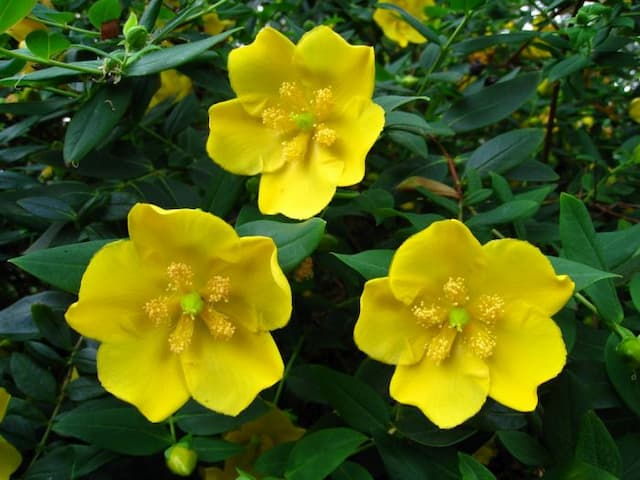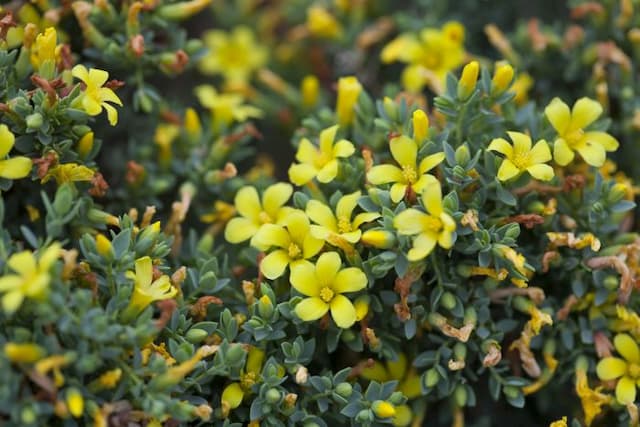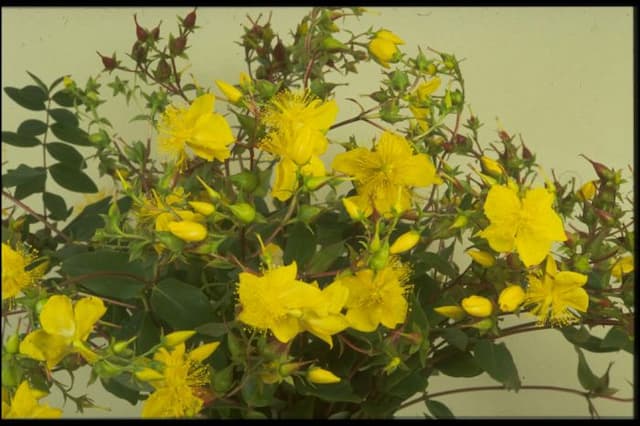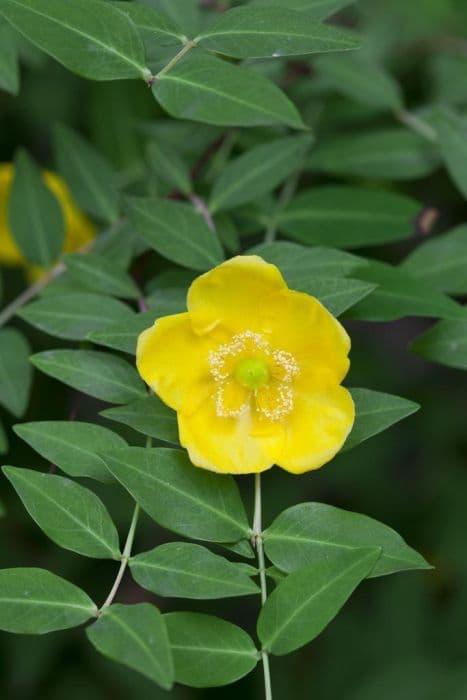St John's Wort Hypericum subsessile

ABOUT
The plant commonly referred to as Hypericum subsessile has a distinctive appearance characterized by its upright stems that hold aloft bright yellow flowers. These flowers typically have five petals radiating around a central, prominent cluster of stamens which often appear bushy and are a key attractor for pollinating insects. Beneath the flowers, the foliage provides a lush background composed of oval to oblong leaves that are commonly rich green, lending a full and dense appearance to the plant's overall structure. The leaves may have a slightly glossy finish and can appear to be somewhat leathery, offering a satisfying texture upon touch. This plant often displays a shrubby habit, which contributes to its bushy and rounded appearance, making it a popular choice in gardens where it can serve as an ornamental feature due to its vibrant coloration and attractive form.
About this plant
 Names
NamesFamily
Hypericaceae.
Synonyms
There are no widely recognized common names for Hypericum subsessile.
Common names
Ascyrum subsessile, Hypericum carolinianum, Hypericum galioides var. laevipes, Sarothra subsessile.
 Toxicity
ToxicityTo humans
Hypericum subsessile, commonly known as St. John's wort, is considered to have a low toxicity level for humans when ingested in small amounts. It is commonly used in herbal medicine for its potential antidepressant effects. However, it can cause some adverse reactions, especially when taken in large quantities or when it interacts with various medications. Symptoms of poisoning from excessive intake can include gastrointestinal disturbances, confusion, dizziness, increased sensitivity to sunlight (photosensitivity), and in severe cases, it can affect the nervous system. It's important to consult with a healthcare provider before using St. John's wort, particularly if you are taking other medications.
To pets
Hypericum subsessile, known as St. John's wort, can be toxic to pets, particularly dogs, cats, and horses. The main concern is the compound hypericin, which can lead to photosensitivity, causing skin irritation and inflammation under sun exposure. Ingesting large amounts can cause additional symptoms such as gastrointestinal upset, including vomiting and diarrhea. In severe cases, it can lead to neurological symptoms like depression and confusion. If your pet has ingested St. John's wort and is showing symptoms of poisoning, it's important to contact a veterinarian promptly.
 Characteristics
CharacteristicsLife cycle
Perennials
Foliage type
Deciduous
Color of leaves
Green
Flower color
Yellow
Height
1-2 feet (30-60 cm)
Spread
1-2 feet (30-60 cm)
Plant type
Shrub
Hardiness zones
5
Native area
Japan
Benefits
 General Benefits
General Benefits- Ornamental value: Hypericum subsessile, commonly known as Dwarf St. John's Wort, adds visual appeal to gardens with its bright yellow flowers and dense, shrubby form.
- Wildlife attraction: The flowers of Dwarf St. John's Wort attract pollinators such as bees and butterflies, supporting local ecosystems.
- Ground cover: The plant can serve as an effective ground cover, reducing soil erosion and suppressing weeds due to its low-growing habit.
- Tolerant to various conditions: It is generally tolerant to a range of soil types and conditions, making it a hardy choice for gardens.
- Low maintenance: Dwarf St. John's Wort requires minimal care once established, making it suitable for low-maintenance landscapes.
 Medical Properties
Medical PropertiesThis plant is not used for medical purposes.
 Air-purifying Qualities
Air-purifying QualitiesThis plant is not specifically known for air purifying qualities.
 Other Uses
Other Uses- As a dye plant: Hypericum subsessile can be used as a source of natural dye for textiles, yielding colors that range from yellow to deep red depending on the mordant used.
- Insect repellent: The oils and extracts of the plant have been reported to have insect repellent properties, potentially useful in gardens or when applied on the skin.
- Garden aesthetics: Because of its attractive flowers, this plant can be used for ornamental purposes to enhance the visual appeal of gardens and landscapes.
- Crafts material: Dried stems and flowers of the plant can be incorporated into floral arrangements, wreaths, and other craft projects for a touch of natural beauty.
- Photography subject: The vibrant flowers and overall structure of the plant make it a popular subject for botanical photography and artistry.
- Erosion control: The plant's root system can help stabilize soil and prevent erosion when planted on slopes or areas prone to soil degradation.
- Livestock feed: Though not a primary source of fodder, the plant might be used as a supplementary grazing option for certain livestock.
- Naturalizing: The plant is suitable for wildflower meadows and naturalized areas where its tendency to self-seed is an advantage for maintaining a robust plant population.
- Educational resource: Hypericum subsessile can serve as a resource in educational settings for lessons in botany, horticulture, and ecology.
- Companion planting: It may be used in companion planting to attract pollinators or as part of a pest management strategy in a holistic approach to garden health.
Interesting Facts
 Feng Shui
Feng ShuiThe St. John's Wort is not used in Feng Shui practice.
 Zodiac Sign Compitability
Zodiac Sign CompitabilityThe St. John's Wort is not used in astrology practice.
 Plant Symbolism
Plant Symbolism- Protection: Hypericum, commonly known as St. John's Wort, has historical associations with warding off evil spirits and is believed to have protective qualities.
- Healing: Due to its medicinal properties, St. John's Wort symbolizes healing both in physical and emotional terms.
- Strength: The resilience and hardiness of St. John's Wort, growing in a wide range of conditions, mirror the symbolic representation of inner strength.
- Light and Positivity: St. John's Wort blooms around Saint John's Day (June 24th) when days are long and bright, symbolizing positivity and the triumph of light over darkness.
 Water
WaterTo properly water a Hypericum subsessile, commonly known as the Creeping St. John's Wort, it's important to keep the soil evenly moist but not waterlogged. During the active growing season in spring and summer, water the plant when the top inch of soil feels dry, approximately once a week, using about 1 gallon of water per watering for a medium-sized plant. Reduce watering in the fall and winter when the plant's growth slows down, watering maybe only every two to three weeks with the same amount of water. Always check the soil moisture level before watering to avoid overwatering, which can lead to root rot.
 Light
LightCreeping St. John's Wort thrives in full sun to partial shade conditions. The best spot for this plant would be an area that receives at least 6 hours of direct sunlight daily, although it can also tolerate light shade. Avoid placing it in deep shade, as this can lead to poor flowering and leggy growth.
 Temperature
TemperatureCreeping St. John's Wort prefers temperate climates, ideally between 60 and 75 degrees Fahrenheit. It can withstand temperatures as low as 50 degrees Fahrenheit and as high as 80 degrees Fahrenheit without adverse effects. Extreme cold or frost can damage the plant, so ensure protection if temperatures drop significantly.
 Pruning
PruningPruning Creeping St. John's Wort helps to shape the plant, encourage bushier growth, and remove dead or diseased stems. Prune the plant lightly in early spring before new growth starts and again after flowering if needed to maintain its shape. Regular pruning is typically done once a year, but you can also remove spent flowers throughout the growing season to encourage more blooms.
 Cleaning
CleaningAs needed
 Soil
SoilHypericum subsessile, commonly known as Shrubby St. John's Wort, thrives best in well-draining soil with a slightly acidic to neutral pH of about 5.5 to 7.0. A good soil mix for this plant would consist of loamy or sandy soil amended with peat moss or pine bark to improve drainage and aeration. Adding perlite also aids in preventing waterlogging, which can lead to root rot.
 Repotting
RepottingShrubby St. John's Wort typically needs to be repotted every 2-3 years to refresh the soil and accommodate growth. It's best to repot in early spring before the onset of the growing season, which can provide the plant with a fresh start and more room for the roots to expand.
 Humidity & Misting
Humidity & MistingShrubby St. John's Wort prefers moderate humidity levels, mirroring its natural environment. The best humidity range for this plant is between 40% to 60%. While it can tolerate some degree of variability, extremely high or low humidity levels should be avoided to maintain plant health.
 Suitable locations
Suitable locationsIndoor
Ensure bright indirect light and avoid overwatering.
Outdoor
Place in partial sun, protect from harsh elements.
Hardiness zone
5-9 USDA
 Life cycle
Life cycleHypericum subsessile, commonly known as St. John's Wort, begins its life cycle with seed germination, which occurs in favorable conditions of warmth and light. The seedling stage follows, where the plant develops true leaves and begins photosynthesis. As it enters the vegetative stage, St. John's Wort establishes a root system and produces a rosette of leaves, later developing into a mature plant with a woody base and numerous branches. The flowering stage is marked by the emergence of bright yellow flowers, typically in summer, which are pollinated by insects. Following pollination, the plant produces capsules filled with numerous small seeds, completing the reproductive stage. Finally, as a perennial plant, it may enter a period of dormancy during unfavorable seasons, only to regrow from its rootstock with the return of favorable conditions.
 Propogation
PropogationPropogation time
Spring to early summer
The most popular method of propagating Hypericum subsessile, commonly known as Shrubby St. John's Wort, is through semi-hardwood cuttings. This typically occurs during the late summer months. Select healthy, mature stems and cut segments about 6 inches (15 cm) long, making sure each cutting has at least a couple of leaves. Strip off the leaves from the lower half of the cutting and dip the cut end into a rooting hormone to encourage root growth. Afterward, place the cuttings in a well-draining potting mix, ensuring the leafless part of the cutting is buried. The cutting should then be kept evenly moist and in a warm place with indirect light until roots have established, which can take several weeks. Once rooted, the new Shrubby St. John's Wort plants can be carefully transplanted into their permanent locations.









